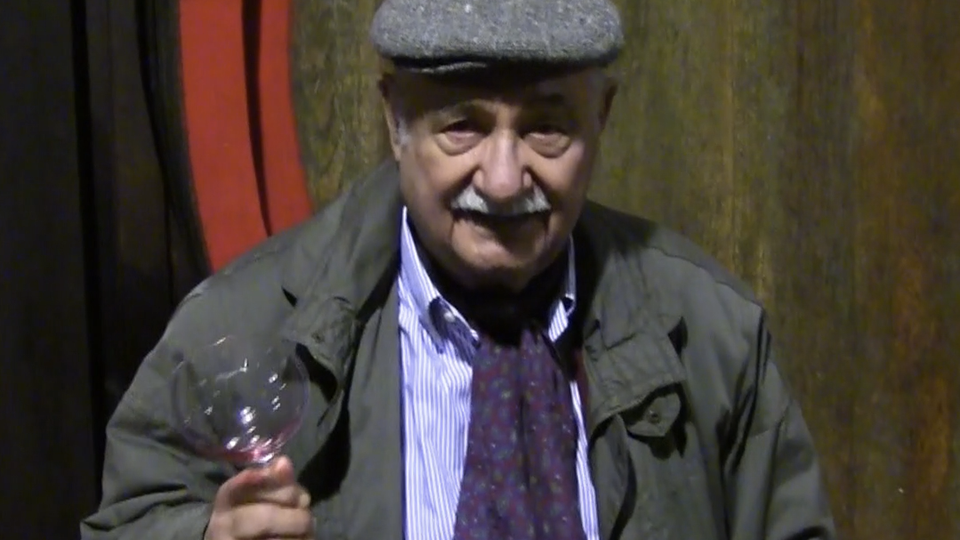Browse using the new Vinous website now. Launch →
Printed by, and for the sole use of . All rights reserved © 2015 Vinous Media
Remembering Gianfranco Soldera
BY ANTONIO GALLONI | APRIL 4, 2019
Segue Versione Italiana
In a brilliant career that spanned five decades, Gianfranco Soldera established himself as one of the world’s most inspired and iconic winemakers. His untimely passing in an accident last February leaves an immeasurable void. Soldera’s wines remain an enduring legacy of his remarkable life and complex, dynamic personality.
Born in 1937, Gianfranco Soldera grew up in Milan, where he spent the first part of his professional career as an insurance broker. As a young man Soldera tasted the great wines of Piedmont and later became close with many of those growers and their families. Giovanni Conterno, Bartolo Mascarello, Giuseppe Mascarello and Battista Rinaldi were all peers, as was Josko Gravner. Soldera remained close with those growers, and later, their children, until his passing. After trying unsuccessfully for years to find land in Piedmont, Soldera chanced upon a magical piece of ground in Montalcino. At the time, the prevailing wisdom on vineyards dictated that the best sites were south-facing, as these were the warmest sites. Back then the issue was achieving full ripeness. But Soldera had a different philosophy. He chased luminosity above all else. And so Case Basse was ideal. The west-facing site was perfectly suited to capturing the entirety of the day’s sunlight. The first vines were planted in 1972. Shortly thereafter, Soldera released his first wines from Case Basse.
Multimedia: Gianfranco Soldera in his cellar
I was fortunate to start buying Soldera’s Brunellos before they became prohibitively expensive, although they were always pricey by Brunello di Montalcino standards. Several private cellars I bought became my personal education to these wines. I always marveled at how gracefully Soldera's Brunellos aged. But it wasn’t just the Brunellos that were fabulous. Soldera’s first release, the 1975 Rosso dei Vigneti di Brunello di Montalcino (Rosso from Brunello di Montalcino vineyards), made from vines planted in 1972, was still fresh and wonderfully expressive when I last tasted it a few years ago. And the finest wines – the 1983, 1990, 1999, 2002 and 2004 Riservas – to name just a handful, were and remain truly epic.
I had an appointment to visit the estate in 2017, in late August. The weeks leading up to harvest are always a fascinating time to see vineyards, as all the work in the field has been done, and it is easy to see who has worked diligently, and who has not. At the last minute, Soldera cancelled with no explanation, something that had never happened before. I imagined he preferred to concentrate on his vineyards given the very early harvest that year. A few days later Soldera wrote, “I apologize, but Saturday the 26th of August I started the harvest, which was very hard. Yesterday I finished destemming the fruit, maniacally sorting berry by berry. I have two tanks with superb musts that will blow you away when you taste them (or the wines made from them). Given the delicateness of the harvest and the berry by berry selection, I absolutely had to be in the winery and supervise all of the work. I would have never imagined picking my Sangiovese in August, but one has to always be willing to learn and follow nature to the maximum.”

The young 2017 musts in
fermentation.
Soldera was a man of extreme conviction, but I had never heard him express so much enthusiasm for a young vintage. As it turns out, I had a few days left in Italy, so I asked about visiting in early September. Ordinarily I would not have dropped everything to make the 5-hour drive to Montalcino. We were celebrating my father’s 80th birthday that weekend. But I have a rule for winemakers of a certain age, and that is that I will always make time to see them no matter what, because you just never know. And so I left a family gathering early and dropped the kids off with their grandparents to make the drive down to Montalcino for the day. We tasted the 2017s. They were indeed stunning, even as young musts in fermentation. It was the last time I saw him.
Soldera had that same boyish enthusiasm about all of his projects, whether it was the drainage system he had created to remove excess water from the vineyards, his custom glasses, his donation to charitable causes of the tiny amount of 2010 he produced, and, most importantly, the research he had done on his Sangiovese from Case Basse and the Premio Soldera award he sponsored every year for a young researcher working on Sangiovese.
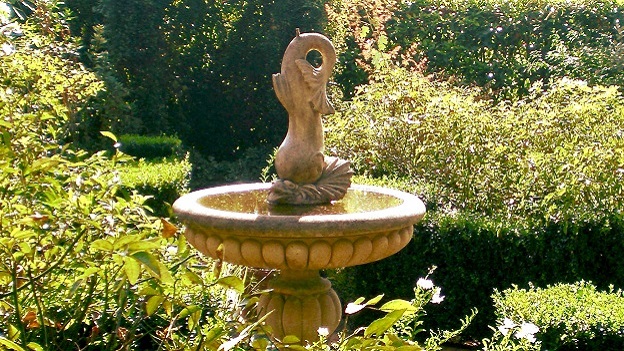
The dolphin seen on
the fountain in Graziella Soldera’s botanical garden also appears on the
Soldera label and is said to have been sacred to Dionysus, the Olympian god of
winemaking
"We will get over it and move on,” Soldera told me dispassionately just a few days after a disgruntled former employee committed a shocking act of vandalism when he opened the spigots on all the large casks in the cellar, causing six vintages of wine to flow into the drains, lost forever. But Soldera was not an easy person. He expressed opinions forcefully, sometimes perhaps with a level of excess that was offensive to those who might not have had the will to look beyond the words and the tone with which they were delivered. I didn’t always agree with him, but I will always take passion and conviction over apathy and indifference. And then, there were the wines…
How could his 2002 be so deep and rich in a vintage in which most wines were washed out? The 2003 was remarkably harmonious for a wine from that torrid vintage. And what about the 2014? The last time I sampled it from cask, it was deeply moving. Tasting in the cellar was always the same routine. We tasted the wines from cask to cask. I wanted to taste every single cask, Soldera often preferred to show just one wine per vintage, especially once he started bottling Riservas only. The discussion of which wines to taste was a recurring theme during my visits. Sometimes I could convince Soldera to taste every cask, and sometimes not. No visit was ever the same.
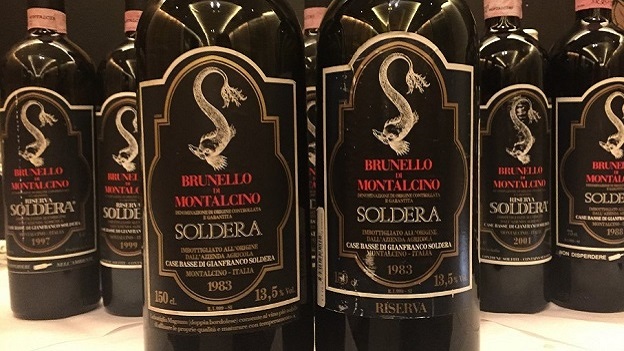
In 2009 I was on vacation in Tuscany with my family. It was
the summer of a torrid year when the stress of the heat was evident everywhere.
I called Soldera at the last minute to ask if he could see us. I never expected
him to actually agree, as all of my previous visits had been scheduled well in advance, but he
said yes. A few days later we were in Montalcino. When Soldera saw my son,
Giulio, then three, he immediately took out his shears and cut off a bunch of
juicy grapes right off the vines. “These have to be the most expensive table
grapes in the world,” I thought to myself. Even though it was August, the
grapes tasted like candy. They were so good. When we got back to the US, Giulio
asked his mother why the grapes from the supermarket did not taste like those
he had eaten in the vineyard in Tuscany…
After the tasting, Soldera insisted on having lunch at Il Leccio, his favorite hangout in Sant’Angelo in Colle. Soldera ordered the famous Fiorentina T-bone steak for all of us. I mentioned I did not think Giulio, a finicky eater, would eat the meat. “You don’t understand anything about food,” was the reply. So, that was that. A little while later the steak arrived, seared on the outside and rare on the inside. I was sure Giulio would not touch it. Soldera took a few slices and cut off the charred outer layer, precisely the part most Americans adore. “That’s where all the toxins are,” he explained. Soldera then cut the rest of the rare meat into small pieces. Giulio devoured it. “You see, children instinctively know what is good, and what is not.”

Sangiovese at Case
Basse just before harvest
Over the years, I was also fortunate to host or attend numerous verticals. The first was in 2007, when, along with a dear friend, I organized a charity tasting going back to 1977, the debut vintage for the Brunello. It was a truly remarkable evening, with so many highlights. Our retrospective In London in 2016 was unforgettable for how consistently brilliant the wines were.
I have always believed that the best Italian wines can stand head to head with the finest wines from anywhere in the world. In 2012, Lalou Bize-Leroy invited me to lunch at Domaine d’Auvenay, part of the ritual of tasting the Domaine Leroy and Domaine d’Auvenay wines in those days. I knew she would open unspeakably rare bottles at lunch, and that has always made me feel uncomfortable. So I accepted the lunch invitation on one condition: that I would bring the wines. Much to my surprise (really more of a shock), she agreed. I wanted to bring the very best I could, wines she would have never tasted, from growers who shared similar philosophies and aesthetic values. For the Champagne, I chose Cédric Bouchard’s Blanc de Blancs Haut-Lemblée. For the red, it could only be one wine. Soldera’s 1990 Brunello di Montalcino Riserva, without question his greatest wine. She loved it. And that is from another uncompromisingly driven grower who never minces words and whose entire life centers almost exclusively around the greatest wines of Burgundy. I had a second bottle. I took it to a dinner in Meursault a few days later. Jean-Marc Roulot, Guillaume d’Angerville, Christophe Roumier, Dominique Lafon. They were all there. And the Soldera 1990 Riserva was the first bottle that disappeared. In an instant.
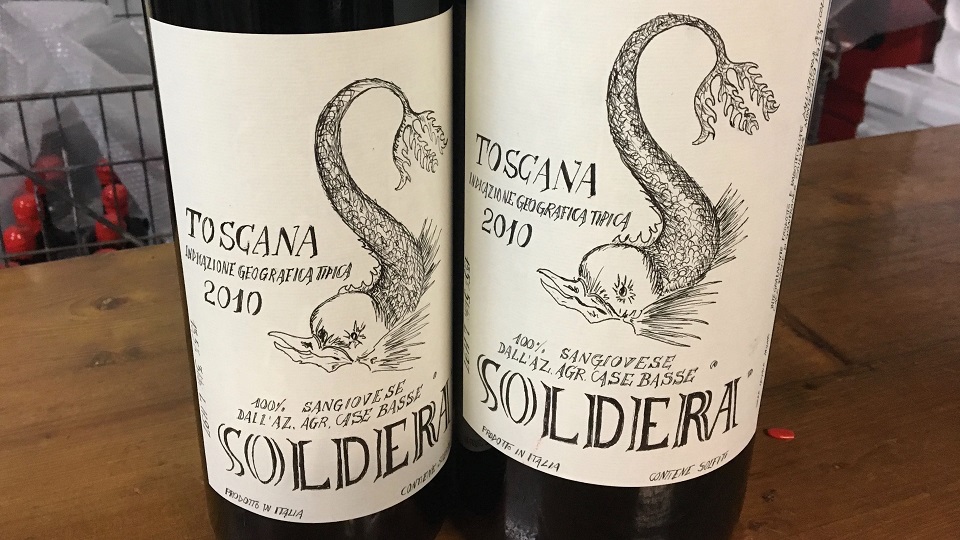
Soldera used this
special hand-drawn rendition of his label for his 2010 Sangiovese. Most of the
production was lost in an act of vandalism in 2012. Soldera decided to donate
the entirety of the small amount he was able to bottle to various charitable
causes
On February 16, 2019, Soldera took one last drive around his vineyards, just as he had done countless times before. I suppose it is fitting that Soldera passed away among the vines he loved so deeply. Soldera is survived by his wife, Graziella, their two children Monica and Mauro, and their families, along with numerous extraordinary wines that will continue to thrill those fortunate enough to own them for many years to come.
Ricordando Gianfranco Soldera
DI ANTONIO GALLONI | 4 APRILE 2019
In una carriera brillante durata cinque decenni, Gianfranco Soldera si è affermato come uno dei produttori di vino più ispirati e iconici al mondo. La sua scomparsa prematura in un incidente lo scorso febbraio lascia un vuoto incommensurabile. I vini di Soldera rimangono un'eredità duratura della sua vita straordinaria e della sua complessa e dinamica personalità.
Nato nel 1937, Gianfranco Soldera si formò a Milano, dove trascorse la prima parte della sua carriera professionale come broker di assicurazioni. Da giovane Soldera assaggiò i grandi vini piemontesi diventando amico di questi produttori e delle loro famiglie. Giovanni Conterno, Bartolo Mascarello, Giuseppe Mascarello e Battista Rinaldi erano tutti colleghi, così come Josko Gravner. Queste relazioni si estesero alla seconda generazione di queste famiglie e più recentemente anche ai loro figli, con cui Soldera ha mantenuto strette amicizie fino alla sua morte. Dopo aver cercato invano per anni un vigneto da comprare in Piemonte, Soldera trovò un pezzo di terreno magico a Montalcino. A quel tempo, la convinzione prevalente sui vigneti era che i siti migliori fossero esposti a sud, poiché erano i più caldi. Allora uno dei maggiori problemi era il raggiungimento della piena maturità del grappolo. Ma Soldera aveva una filosofia diversa. Cercava la luminosità sopra ogni altra cosa. E così Case Basse si dimostrò l'ideale. Il sito rivolto a ovest era perfetto per catturare l'intera luce del giorno. Le prime viti furono piantate nel 1972. Poco dopo iniziarono ad uscire i primi vini di Case Basse.
Multimedia: Gianfranco Soldera nella sua cantina
Fortunatamente, iniziai a comprare i Brunello di Soldera prima che diventassero carissimi, nonostante siano sempre stati molto costosi secondo gli standard del Brunello di Montalcino. Ho avuto modo di acquistare i suoi vini da diverse cantine private che hanno contribuito alla mia educazione personale su questi vini. Mi sono sempre meravigliato di come i suoi Brunello evolvevano in bottiglia. Ma non solo i Brunello erano favolosi. Il primo vino di Soldera, il Rosso dei Vigneti di Brunello di Montalcino del 1975, ottenuto da vitigni piantati nel 1972, era ancora fresco e meravigliosamente espressivo quando lo assaggiai alcuni anni fa. E i vini più importanti - le Riserve del 1983, 1990, 1999, 2002 e 2004 - per citarne solo una manciata, erano e rimangono davvero epiche.
Nel 2017 avevo un appuntamento per visitare l’azienda a fine agosto. Le settimane che precedono la vendemmia sono sempre un periodo affascinante per vedere i vigneti, poiché tutto il lavoro è stato fatto, ed è facile capire chi ha lavorato diligentemente e chi no. All'ultimo minuto, Soldera annullò senza spiegazioni, non era mai successo prima. Immaginai che preferisse concentrarsi sui suoi vigneti dato la vendemmia molto anticipata.
Qualche giorno dopo mi scrisse: "Scusami ma sabato 26 agosto ho iniziato la vendemmia che è stata difficilissima; ieri ho finito di diraspare scegliendo in modo maniacale acino per acino ed ho due tini con un grandissimo mosto che ti stupirà quando lo assaggerai (od assaggerai il vino che ne seguirà). Data la delicatezza della raccolta e della selezione di ogni acino, dovevo assolutamente essere presente e controllare tutte le operazioni. Mai avrei pensato di vendemmiare il mio Sangiovese in Agosto, ma si deve imparare sempre ed assecondare al massimo la natura.”
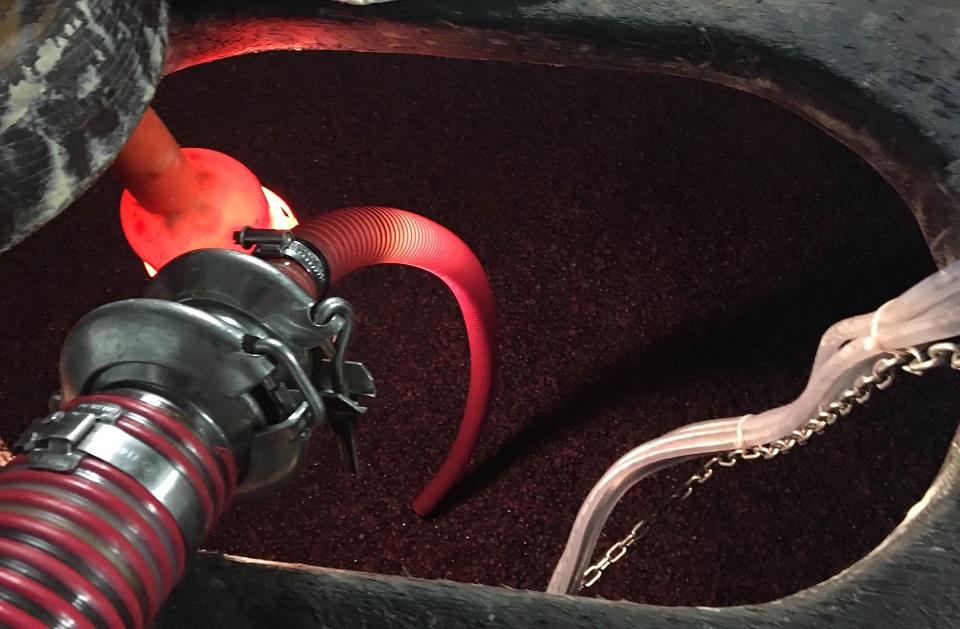
Un mosto del 2017 in fermentazione
Soldera era un uomo di convinzioni estreme, ma non l'avevo mai sentito esprimere così tanto entusiasmo per un’annata giovane. Mi rimanevano ancora alcuni giorni da passare in Italia, quindi gli richiesi di visitarlo all'inizio di settembre. Normalmente non avrei lasciato la mia famiglia per fare il viaggio di 5 ore per Montalcino. Quel weekend festeggiavamo l'ottantesimo compleanno di mio padre. Ma ho una regola per i vignaioli di una certa età, e cioè che troverò sempre il tempo per vederli, non importa cosa stia facendo, non si sa mai. E così, lasciai presto una riunione di famiglia e i bambini con i nonni per guidare fino a Montalcino per la giornata. Abbiamo assaggiato i 2017. Erano davvero stupefacenti, anche se solamente giovani mosti in fermentazione. È stata l'ultima volta che l'ho visto.
Soldera aveva l'entusiasmo di un bambino per tutti i suoi progetti: il sistema di drenaggio che aveva creato per rimuovere l'acqua in eccesso dai vigneti, i bicchieri personalizzati, la donazione a cause benefiche della piccola produzione di 2010 , l’importante ricerca sul suo Sangiovese di Case Basse ed il premio Premio Soldera che ha sponsorizzato ogni anno per un giovane ricercatore con interesse mirato al Sangiovese.

Il delfino visto sulla fontana nel giardino
botanico di Graziella Soldera appare anche sull'etichetta Soldera e si dice che
sia stato sacro a Dioniso, il dio olimpico della vinificazione
"Ci passeremo sopra e andremo avanti", mi raccontò spassionatamente Soldera pochi giorni dopo che un ex dipendente scontento commise uno scioccante atto di vandalismo quando aprì i rubinetti su tutte le grandi botti in cantina, facendo scorrere sei annate di vino nelle fognature, persi per sempre. Ma Soldera non era una persona facile. Esprimeva le proprie opinioni con forza, a volte forse con un eccesso offensivo per coloro non disposti a guardare oltre le parole ed il tono usato. Non ero sempre d'accordo con Lui, ma preferisco sempre la passione e la convinzione all'apatia e all'indifferenza. E poi, c'erano i vini ...
Come poteva il suo 2002 essere così profondo e ricco in un'annata in cui la maggior parte dei vini erano scarsi? Il 2003 è straordinariamente armonioso per un vino di un’annata torrida. E per quanto riguarda il 2014? L'ultima volta che l'ho provato dalla botte, è stato profondamente commovente. Le degustazioni in cantina si svolgevano sempre con la stessa routine. Assaggiavamo i vini da botte a botte. Io preferivo assaggiare ogni singola botte, ma Soldera spesso sceglieva di mostrare solo un vino per annata, specialmente dopo aver iniziato ad imbottigliare solo Riserve. La discussione su quali vini assaggiare era un tema ricorrente durante le mie visite. A volte riuscivo a convincere Soldera ad assaggiare ogni botte, a volte no. Nessuna visita era uguale.
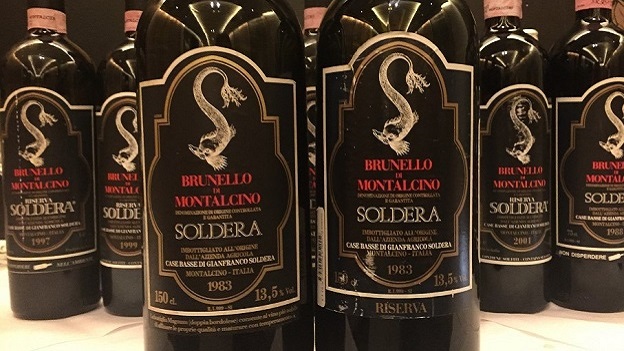
Nel 2009 ero in
vacanza in Toscana con la mia famiglia. Era l'estate di un’annata torrida in
cui lo stress del caldo era evidente ovunque. Chiamai Soldera all'ultimo minuto
per chiedere se avessimo potuto visitare l’azienda. Non mi sarei mai aspettato
che lui sarebbe stato d'accordo, siccome tutte le mie precedenti visite da lui erano sempre state programmate con largo anticipo, ma lui accettò. Pochi giorni dopo eravamo a Montalcino. Quando Soldera vide mio figlio Giulio,
allora aveva tre anni, tirò fuori subito le sue forbici e tagliò un grappolo di
uva dalle viti. "Queste devono essere le uve da tavola più costose
del mondo", pensai. Anche se era agosto, l'uva sapeva di caramelle. Era
così buona. Quando tornammo negli Stati Uniti, Giulio chiese a sua madre perché
le uve del supermercato non erano buone quanto quelle che aveva mangiato nel
vigneto in Toscana...
Dopo la degustazione, Soldera volle pranzare al Leccio, il suo ritrovo preferito a Sant'Angelo in Colle. Soldera ordinò la famosa bistecca alla fiorentina per tutti. Dissi che Giulio, schizzinoso quando si tratta di cibo, non avrebbe mangiato la carne. "Non capisci niente di cibo", fu la risposta. Poco dopo arrivò la bistecca, scottata all'esterno e praticamente cruda all'interno. Ero sicuro che Giulio non l'avrebbe toccata. Soldera prese alcune fette e tagliò lo strato esterno carbonizzato, proprio la parte più amata dagli americani. "Ecco dove sono tutte le tossine", spiegò. Soldera poi tagliò il resto della carne cruda in piccoli pezzi. Giulio la divorò. "Vedi, i bambini sanno istintivamente ciò che è buono e ciò che non lo è."
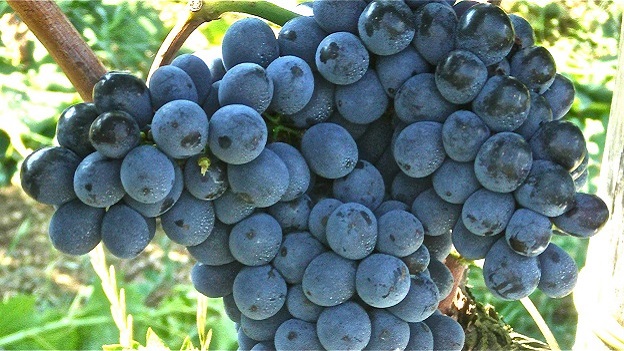
Sangiovese a Case Basse poco prima della vendemmia
Nel corso degli anni, ho avuto la fortuna di ospitare e partecipare a numerose verticali. La prima è stata nel 2007, quando, insieme ad un caro amico, ho organizzato una degustazione di beneficenza fino all’annata del debutto del suo Brunello, la 1977. È stata una serata davvero straordinaria, con molti momenti salienti. La nostra retrospettiva organizzata a Londra nel 2016 è stata anche indimenticabile per quanto i vini si siano dimostrati brillanti.
Ho sempre creduto che i migliori vini italiani possano competere con i migliori vini di qualsiasi parte del mondo. Nel 2012, Lalou Bize-Leroy mi invitò a pranzo a Domaine d'Auvenay, parte del rituale di degustare i vini di Domaine Leroy e Domaine d'Auvenay a quei tempi. Immaginavo che avrebbe aperto bottiglie molto rare a pranzo, e questo mi ha sempre fatto sentire a disagio. Quindi accettai l'invito a pranzo ad una sola condizione: che avrei portato io i vini. Con mia grande sorpresa (in realtà più uno shock), accettò. Volevo portare il meglio che potevo, vini che lei non avrebbe mai assaggiato, da coltivatori che condividevano filosofie e valori estetici simili. Per lo Champagne, scelsi il Blanc de Blancs Haut-Lemblée di Cédric Bouchard. Per il rosso, poteva solo essere un vino. Il 1990 Brunello di Montalcino Riserva di Soldera, senza dubbio il suo più grande vino. Lei ne rimase incantata. Tutto questo da parte di una produttrice pure lei senza compromessi, che non spreca mai le parole e che concentra l’intera vita quasi esclusivamente intorno ai più grandi vini della Borgogna. Avevo una seconda bottiglia. La portai a cena a Meursault pochi giorni dopo. Jean-Marc Roulot, Guillaume d'Angerville, Christophe Roumier, Dominique Lafon. Erano tutti lì. Il Soldera 1990 Riserva fu la prima bottiglia finita a tavola. In un istante.

Soldera ha utilizzato questa speciale versione
disegnata a mano della sua etichetta per il suo Sangiovese del 2010. La maggior
parte della produzione è stata persa in un atto di vandalismo nel 2012. Soldera
ha deciso di donare la totalità della piccola produzione che è stato in grado
di imbottigliare per varie cause benefiche.
Il 16 febbraio 2019 Soldera ha fatto un ultimo giro intorno ai suoi vigneti, proprio come aveva fatto innumerevoli altre volte prima. Suppongo sia giusto che Soldera sia morto tra le vigne che amava così profondamente. Soldera è sopravvissuto da sua moglie, Graziella, i loro due figli Monica e Mauro, e le loro famiglie, insieme a numerosi vini straordinari che continueranno ad entusiasmare coloro che sono abbastanza fortunati da possederli per molti anni a venire.

